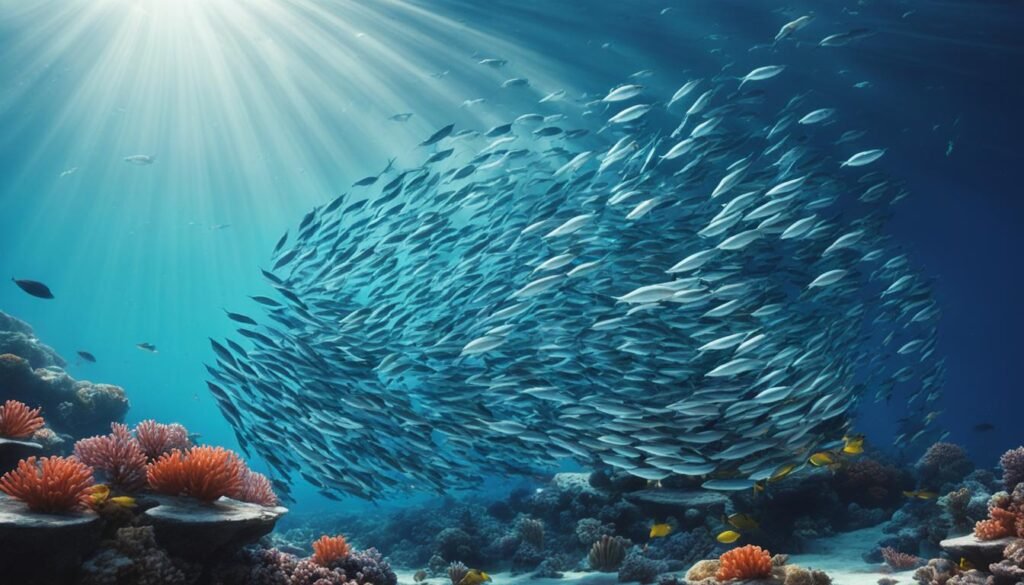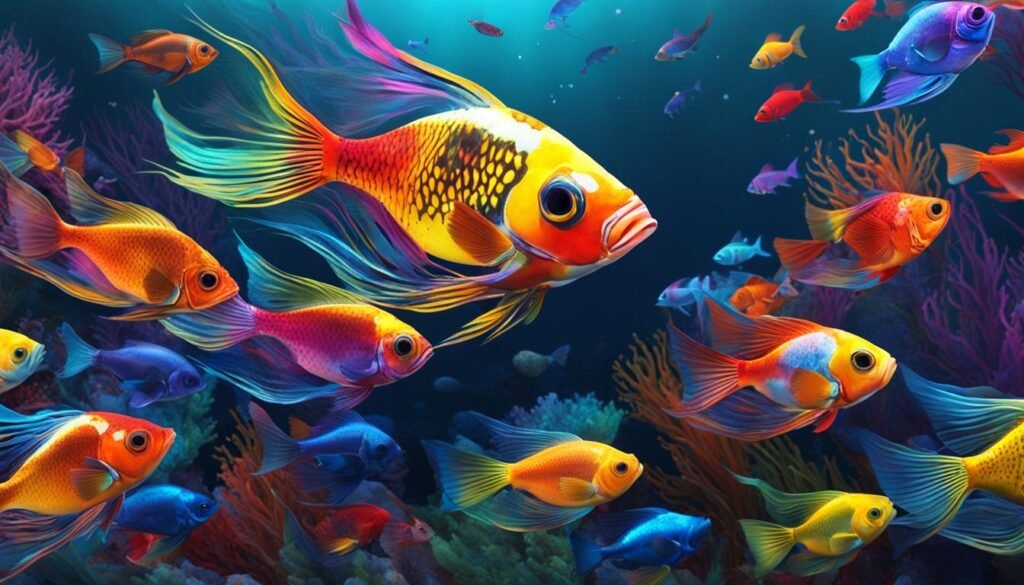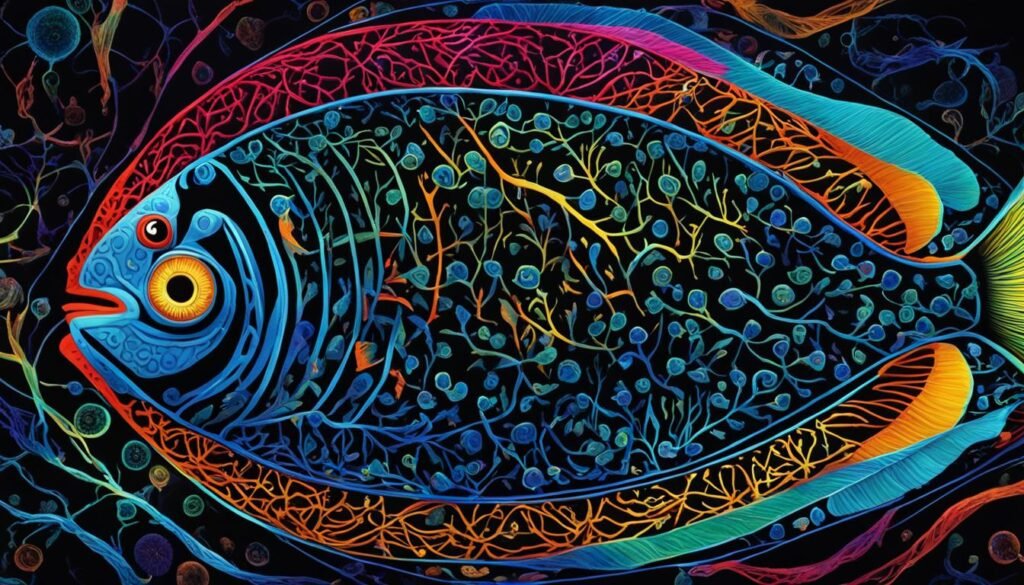Have you ever wondered if fish have a brain?
Are they capable of cognitive functions like humans and other mammals? In this article, we delve into the intriguing world of fish brains to understand their cognitive capabilities and how they influence fish behavior.
Key Takeaways:
- Fish do have a brain that controls their behavior and physiological processes.
- The cognitive capabilities of fish differ from those of mammals and humans.
- Understanding fish brain functionality provides insights into their behavior and survival strategies.
- Ongoing brain research aims to uncover the intricate relationship between fish behavior and their brain structure.
- Fish brains play a crucial role in their adaptive behaviors and response to environmental changes.
Exploring the Behavioral Complexity of Fish
Fish behavior is a fascinating subject that reveals the intricate relationship between their behavior and brain. Environmental changes play a significant role in shaping fish behavior, while habitat preference serves as a determining factor in their survival strategies.
The Intricate Relationship Between Fish Behavior and the Brain
The behavior of fish is closely linked to the complexity of their brain. While fish brains differ from those of mammals and humans, they possess the necessary structures and capabilities to control their behavior and physiological processes. It is through their brain that fish interact with their environment and exhibit a wide range of behaviors.
How Environmental Changes Influence Fish Behavior
Environmental changes, such as fluctuations in temperature or variations in water quality, have a profound impact on fish behavior. Fish exhibit adaptive responses to these changes, which can include alterations in feeding patterns, migration routes, or reproductive behaviors. Understanding the environmental factors that affect fish behavior is crucial for both conservation efforts and fisheries management.
Understanding Habitat Preference: Pelagic vs. Demersal Fish
Habitat preference is another key determinant of fish behavior. Fish can be categorized into pelagic and demersal species based on their habitat preference. Pelagic fish thrive in the open waters, where they display behaviors such as shoaling, migration, and schooling. On the other hand, demersal fish prefer the bottom of water bodies and exhibit behaviors like foraging, territoriality, and burrowing. The distinct habitats of pelagic and demersal fish result in distinct behavioral adaptations necessary for their survival.
By exploring the behavioral complexity of fish, we gain insights into their brain function, the impact of their environment, and the influence of their habitat preference. This knowledge not only enriches our understanding of fish behavior but also has practical applications for conservation efforts and the sustainability of fisheries.
Unraveling Fish Schooling and Social Structures
Fish are known for their intriguing social behavior, often observed in schooling and aggregating behaviors. In this section, we will delve into the hierarchical dynamics of fish schooling and the role of the pecking order in fish aggregations.

The Hierarchical Dynamics of Schooling Behaviors
Fish often exhibit schooling behavior, where they swim in coordinated groups. Within a school, there is a specific hierarchy that organizes the behavior of individual fish. This hierarchical structure ensures smooth coordination, efficient movement, and enhanced predator avoidance.
The hierarchy within a fish school is established through various factors, including size, age, dominance, and social interactions. Dominant individuals take on leadership roles, guiding the group’s movements and decision-making. Subordinate fish follow the lead of dominant individuals, maintaining precise spacing and alignment, creating the mesmerizing patterns often seen in fish schools.
Pecking Order and Its Role in Fish Aggregations
In fish aggregations, a concept known as the pecking order becomes relevant. The pecking order refers to the social hierarchy and dominance relationships within a group of fish. Dominant individuals, usually larger and more experienced, exert control over the behaviors of other fish.
The pecking order plays a crucial role in the cohesion and functioning of fish aggregations. Dominant individuals often occupy prime positions in the group, gaining access to resources, such as food and mates, more easily. They also influence the collective behavior and decision-making of the group, ensuring that the aggregation functions as a unified entity. Subordinate fish in the pecking order may have restricted access to resources and must navigate social dynamics within the group.
Understanding fish schooling and social structures provides valuable insights into the intricacies of fish behavior and the strategies they employ for survival and successful reproduction.
Stress and Survival: Adaptive Behaviors in Fish
Fish exhibit a range of adaptive behaviors that play a crucial role in their survival. These behaviors are triggered by stressful situations and enable fish to navigate their environment effectively. Let’s explore two key mechanisms that fish employ in response to stress: aggression and fright responses.
The Mechanisms of Aggression and Fright Responses
When faced with a threat, fish may exhibit aggressive behavior as a means of self-defense. This aggression can include territorial disputes, fighting for resources, or repelling predators. By displaying dominance and asserting their presence, fish can effectively ward off potential threats and protect their territories.
On the other hand, fright responses are another important adaptive behavior in fish. When fish feel threatened or frightened, they may display behaviors such as rapid swimming, hiding, or freezing in place. These responses help fish evade predators by minimizing their chances of being detected or captured.
Camouflage and Predation: Behavioral Adaptations for Survival
Camouflage is a remarkable adaptive behavior employed by many fish species. Through changes in coloration, pattern, and body posture, fish can blend seamlessly into their surroundings, making it difficult for predators to spot them. This form of camouflage acts as a protective shield, allowing fish to avoid predation and increase their chances of survival.
Predation itself also drives the development of various adaptive behaviors in fish. For example, some fish have evolved intricate escape maneuvers to outmaneuver predators, while others rely on mimicry to imitate harmless or unpalatable species. These adaptive behaviors enable fish to reduce their vulnerability to predation and enhance their chances of survival.
In conclusion, fish employ diverse adaptive behaviors in response to stress. From aggression and fright responses to camouflage and predation strategies, these behaviors are essential for fish to navigate their environment and increase their chances of survival. Understanding these adaptive behaviors offers valuable insights into the complex world of fish behavior and their incredible ability to adapt to changing circumstances.
Feeding Strategies and Territory Defense in Aquatic Life
Fish employ various feeding strategies to obtain food, including active hunting or passive feeding alongside other species. Territory defense is another crucial behavior in aquatic life, where fish protect their living space, food, and potential mates.
How Fish Communicate: The Role of Coloration and Movement
Fish utilize coloration and movement as essential tools for communication. Through these visual signals, they convey vital information to other members of their species and the surrounding environment. Let’s explore two key aspects of fish communication: advertising coloration and courtship displays.
The Significance of Advertising Coloration in Fish
Advertising coloration is a remarkable phenomenon observed in various fish species. It involves the use of vibrant, eye-catching colors to communicate specific messages. These colors serve as visual signals that convey information about an individual fish’s identity, behavior, and intentions.
For example, the vivid and striking colors displayed by many tropical reef fish are often associated with warning signals to potential predators. These colors act as a deterrent, indicating that the fish possess toxins or are otherwise unpalatable. Similarly, some fish use bright colors to indicate aggression, dominance, or territorial boundaries.
Furthermore, certain fish species employ camouflage techniques through adaptive coloration to blend seamlessly into their surroundings. This helps them avoid detection by predators or ambush prey more effectively. By manipulating their coloration, fish can adapt and survive in a wide range of aquatic environments.
Courtship Displays: A Blend of Behavioral and Physiological Changes
Courtship displays are an intricate combination of behavioral and physiological changes employed by fish to attract potential mates. These displays encompass a range of impressive visual performances that showcase the fitness and reproductive abilities of the individuals involved.
During courtship, male fish often exhibit vibrant color patterns, unique body postures, and elegant swimming motions to capture the attention of females. These visual displays communicate the male’s genetic quality, health status, and ability to provide offspring with favorable traits.
In addition to coloration, movement plays a crucial role in courtship displays. Certain fish engage in intricate dance-like routines or perform acrobatic swimming patterns to impress and entice potential mates. These dynamic movements serve as powerful signals of the male’s vitality, agility, and reproductive fitness.
Overall, through advertising coloration and courtship displays, fish engage in a captivating form of non-verbal communication that plays an essential role in their survival, reproduction, and maintenance of social structures.

Does Fish Have a Brain?
Fish do have a brain, although their brain structure and cognitive abilities differ from mammals and humans. The fish brain controls their behavior and physiological processes. While fish may not possess the same cognitive capabilities as humans, they have evolved remarkable adaptations that enable them to navigate their aquatic environments and perform complex tasks.
The fish brain consists of various regions that serve specific functions. These regions include the olfactory bulbs, cerebrum, optic lobes, pituitary gland, cerebellum, and medulla. Each component plays a vital role in regulating fish behavior and ensuring their survival.
One interesting feature of the fish brain is its ability to process sensory information from the surrounding environment. Fish rely on their sensory systems, such as sight, smell, and lateral line, to detect prey, navigate through water currents, and identify potential predators.

The fish brain’s cognitive capabilities, although distinct from humans, allow them to learn and remember information. Studies have shown that certain fish species can respond to external stimuli and exhibit learned behaviors. For example, some species can be trained to recognize and respond to specific visual cues or solve simple problems. These findings highlight the cognitive flexibility and adaptability of fish.
Furthermore, fish’s ability to exhibit complex social behaviors suggests a level of intelligence and cognitive processing that is often underestimated. Many species engage in intricate mating rituals, build elaborate nests, and form hierarchical social structures within their communities.
In conclusion, while fish may not possess the same cognitive capabilities as mammals and humans, they do have a brain that plays a crucial role in controlling their behavior and physiological processes. The study of fish cognition and brain function continues to provide valuable insights into the fascinating world of these aquatic creatures.
Dissecting the Fish Brain: Structure and Functionality
The fish brain is a fascinating organ that plays a crucial role in their physiology and behavior. Let’s take a closer look at the anatomy of the fish brain and its major components.
Anatomy of the Fish Brain and Its Major Components
The fish brain is composed of several distinct parts, each with its own specific functions. These include:
- Olfactory Bulbs: responsible for processing smells and odors.
- Cerebrum: the largest part of the brain, involved in sensory processing and decision-making.
- Optic Lobes: responsible for visual processing and integrating visual stimuli.
- Pituitary Gland: plays a key role in regulating hormone production and balance.
- Cerebellum: involved in motor coordination and balance.
- Medulla: essential for controlling vital functions, such as respiration and heart rate.
Understanding the major components of the fish brain provides valuable insights into the complexity of fish cognition and behavior.
The Role of the Cerebellum and Medulla in Fish Physiology
The cerebellum and medulla are two critical components of the fish brain that contribute to their overall physiology and behavior.
The cerebellum, located at the back of the brain, acts as the coordination center, ensuring smooth and precise motor movements. It plays a vital role in helping fish swim, navigate their surroundings, and catch prey. Additionally, the cerebellum helps maintain balance and equilibrium, allowing fish to maintain stability in diverse aquatic environments.
The medulla, situated at the base of the brain, controls essential bodily functions, including respiration, heart rate, and digestion. It serves as the command center for regulating these vital processes, ensuring the fish’s survival and optimal physiological functioning.
Understanding the role of the cerebellum and medulla provides valuable insights into the intricate mechanisms that underlie fish physiology and behavior.

The fish brain is a complex organ with various components, each serving a specific purpose in the fish’s overall functioning. By studying the structure and functionality of the fish brain, researchers gain a deeper understanding of fish behavior, cognitive abilities, and biological adaptations. This knowledge contributes to our broader understanding of the intricate world of aquatic life and the remarkable diversity of the animal kingdom.
Neuroscience Breakthroughs: Mapping the Fish Brain
Neuroscience research plays a crucial role in unraveling the mysteries of the fish brain. Scientists are dedicated to understanding the complex neuronal networks that govern fish behavior and cognitive processes. Through the innovative technique of connectome mapping, researchers aim to create a comprehensive map of the fish brain, illuminating the intricate connections and functions of its cells.
Connectome mapping is at the forefront of brain research, providing invaluable insights into the inner workings of the fish brain. By examining the neural pathways, researchers can decipher how different regions of the brain communicate and cooperate to control behavior and physiological responses.
Through advanced imaging techniques and sophisticated computational analyses, scientists are progressively mapping the fish brain’s connectome. This map offers a visual representation of the entire set of neuronal connections, revealing the intricacies of the fish brain’s wiring and shedding light on its organizational principles.
Advancements in fish brain mapping have provided valuable knowledge about the cognitive capabilities of fish and enhanced our understanding of their behavior and adaptation to various environments. It serves as a foundation for further exploration into the effects of environmental factors on brain development and function, contributing to both basic and applied research in the field of neuroscience.

| Advantages of Fish Brain Mapping | Significance for Brain Research |
|---|---|
| Reveals the intricate neural connections within the fish brain | Contributes to the understanding of brain organization and function |
| Provides insights into the cognitive capabilities of fish | Advances knowledge of brain evolution and species divergence |
| Enhances understanding of the impact of environmental factors on brain development | Informs research on brain disorders and neurodegenerative diseases |
Fish brain mapping and connectome research represent significant milestones in the study of brain function and cognitive abilities. This exciting field of research holds immense potential for uncovering new discoveries and unlocking the secrets of the fish brain, leading to a deeper understanding of the broader field of brain research.
Evolutionary Insights: From Fish to Humans
Fish play a significant role in the evolutionary history of humans. Understanding the evolution of fish and their relationship to humans provides valuable insights into our origins and the diverse species that have contributed to our lineage.
The Evolutionary Significance of Fish in Human Ancestry
Fish have been a part of Earth’s ecosystems for millions of years, with various species adapting and evolving over time. As vertebrates, fish share certain anatomical and physiological traits with humans, offering clues about our common ancestry.
Through studying fish evolution, scientists have examined the genetic and morphological changes that have occurred throughout the ages. This research has highlighted the fundamental role of fish in shaping the evolutionary path that eventually led to the emergence of humans.
Tiktaalik: The Fishapod That Sheds Light on Our Evolution

One fascinating example of a transitional fossil that provides insights into our evolutionary journey is Tiktaalik. This ancient species, often referred to as a “fishapod,” lived around 375 million years ago. Tiktaalik possessed intermediate characteristics, displaying traits of both fish and tetrapods, the four-limbed vertebrates that include humans.
The discovery of Tiktaalik in the Canadian Arctic region has provided significant evidence of the transition from aquatic to terrestrial life. Its skeletal features, such as limb-like fins and a robust ribcage, indicate a creature that was capable of both swimming in water and supporting its body on land.
This remarkable fossil bridges the gap between fish and land-dwelling organisms, offering valuable insights into the evolution of vertebrates and the lineage that eventually led to the emergence of humans.
Conclusion
In summary, it is evident that fish do have a brain that plays a crucial role in controlling their behavior and physiological processes. Ongoing brain research focused on fish will continue to provide valuable insights into the functionality of fish brains and how it influences their behavior and survival strategies.
The future of brain research holds immense promise for a better understanding of fish and their cognitive capabilities. By exploring the intricacies of the fish brain, scientists can unlock the mysteries surrounding fish behavior and gain valuable knowledge about their evolutionary adaptations.
As we delve deeper into the complexities of the fish brain, we can unravel the mechanisms that underlie fish communication, school formations, adaptive behaviors, and feeding strategies. This deeper understanding may not only enhance our comprehension of fish, but also shed light on how other organisms, including humans, have evolved.
FAQ
Does fish have a brain?
Yes, fish do have a brain that controls their behavior and physiological processes.
What is the relationship between fish behavior and the brain?
Fish behavior is intricately connected to their brain. The brain regulates their behavior and physiological processes.
How do environmental changes affect fish behavior?
Environmental changes such as temperature or water quality can significantly influence fish behavior.
What is the difference between pelagic and demersal fish?
Pelagic fish live in open waters, while demersal fish inhabit the bottom of water bodies.
How do fish school and organize their behavior?
Fish often exhibit schooling behavior, swimming in groups with a specific hierarchy, contributing to the organization and coordination of fish behavior.
What is the role of pecking order in fish aggregations?
The concept of a pecking order is relevant in fish aggregations, where dominant individuals control the behaviors of other fish within the group.
How do fish adapt to stressful situations?
Fish exhibit adaptive behaviors such as aggression to ward off threats and fright responses when feeling threatened or frightened.
What are the behavioral adaptations of fish for survival?
Camouflage and predation are behavioral adaptations that fish employ to enhance their survival in their respective environments.
What feeding strategies do fish use?
Fish use various feeding strategies including active hunting or passive feeding alongside other species.
Why is territory defense important for fish?
Territory defense is a crucial behavior in aquatic life, where fish protect their living space, food, and potential mates.
How do fish communicate?
Fish use coloration and movement as communication tools. Advertising coloration allows fish to send signals to other animals, while courtship displays involve a combination of behavioral and physiological changes to attract potential mates.
What are the major components of the fish brain?
The fish brain is divided into different parts, including olfactory bulbs, cerebrum, optic lobes, pituitary gland, cerebellum, and medulla.
What is the current focus of neuroscience research on fish?
Neuroscience research focuses on mapping the fish brain and understanding its neuronal networks. Connectome mapping, a frontier of brain research, aims to provide a comprehensive understanding of the connections and functions of fish brain cells.
What is the evolutionary significance of fish in human ancestry?
Fish hold evolutionary significance in the ancestry of humans, providing insights into the transition from sea-dwelling creatures to land-dwelling organisms, including humans.
How does Tiktaalik shed light on our evolution?
Tiktaalik, often referred to as a “fishapod,” is a transitional fossil that provides insights into the evolution from sea-dwelling creatures to land-dwelling organisms, including humans.
Source Links
- https://manoa.hawaii.edu/exploringourfluidearth/behavior-and-sensory-systems-fish
- https://www.pbs.org/newshour/science/watch-ideas-light-fishs-brain
- https://www.npr.org/2010/07/05/127937070/the-human-edge-finding-our-inner-fish


